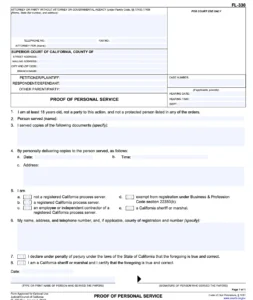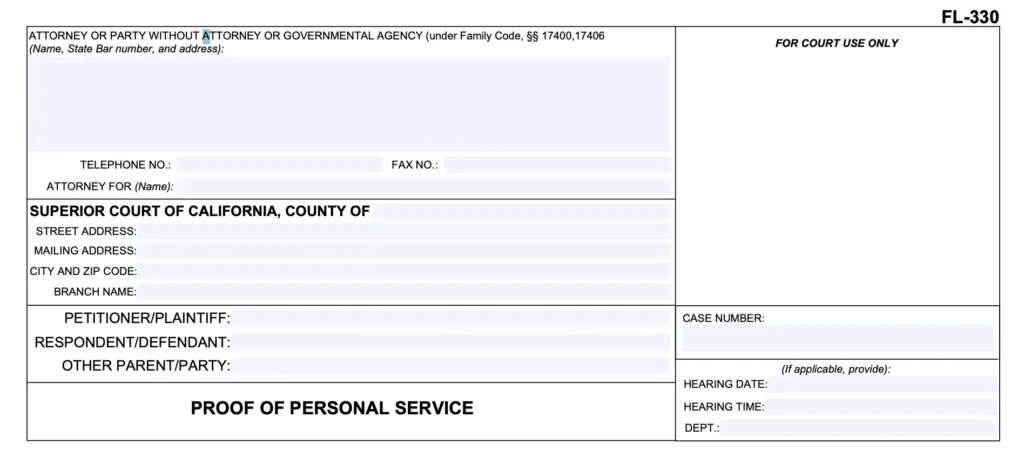Get California Online Divorce Forms for $299 – Limited Time Offer!
Read our blogs to get tips on California uncontested, online, and DIY divorce.


Share

Share
Form FL-330 is your actual proof that you did properly serve divorce papers. Filing it incorrectly (or trying to use it for mail service) can throw a wrench in your case.
In California divorce, FL-330 is used for personal delivery, whereas Form FL-335 is the form you would use for mail service. Some common errors include failing to sign.
Our complete guide on FL-330 will help you file it right. Use The Complete Divorce to check your divorce eligibility or get a FREE trial to our software (with no credit card information required).
Form FL-330 is your official Proof of Personal Service in California divorce. The reason it is important is because it gives the court legal proof that service of the divorce papers was actually made on your spouse.
You are going to use form FL-330 for mail service, such as Respondent’s initial documents ts: FL-120 (Response and Request for Dissolution) and FL-105 if there are children involved.
The FL-330 is never used for service of the Petition for Dissolution, FL-110. Instead, if you are serving the Petition, FL-100, by personal service, use Proof of Personal Service, FL-115.
Also, the Response papers can be served by mail and personal service is not required. If you choose to service by mail, use FL-335.
The FL-330 form is signed by the process server (not you!). You can either complete it for the process server, or your process server can do it. You are responsible for filing the original, signed form with the court clerk. If you do not file it in a timely manner, it can cause a significant delay compared to how long divorce takes in California.
The only difference is in how the documents were served; use Form FL-330 as proof of service when court forms are handed directly to your spouse and use Form FL-335 when the documents are served through the mail.
These forms may not be used interchangeably; you need to select the correct form so that the court can approve your service.
Most of this form will be completed by your server, but you have to complete the details of the case. The main areas you need to complete are your contact information, the information of the person served, the documents served, and the server’s signed declaration. Our service makes the editing and completing of your FL-330 easy and hassle-free.
This upper portion of the FL-330 is for you, the filer, to provide all the necessary identifying information regarding your case and the court where your case is being heard. This is important for proper routing and recording of the form.

In this section, you will enter your information as the filing party with the court. If you are representing yourself, you will provide your legal name, street address and phone number. Write in Self-Represented in the Attorney line.
Do not complete the “State Bar number” and “Fax number”‘ unless you are an attorney.
This section identifies the exact court of your divorce case. You must find and enter the court’s official name (e.g., “County of Los Angeles”), full street address & ZIP Code, mailing address, and branch name (if any). If you file to the wrong court, it will slow things down.
Provide the full legal name of everyone involved in the case. The Petitioner is the spouse that filed the divorce paperwork, and the Respondent is the spouse being served. There is no need to list another parent or party unless a third party is a formally named party to the case.
When your case starts (e.g. filing the Petition for Dissolution of Marriage, FL-100, ) you are assigned a one-of-a-kind case number that you will use moving forward with your matter.
You can fill out the hearing date, time, and department if you are serving papers for a hearing that is already on the calendar, and all of that information is already available. If you don’t have these details, you may leave these fields blank.
This crucial part is done and signed by your server under penalty of perjury, affirming this service of process is correct.

The server must check this box to affirm that they are 18 years of age or older, not a party to the divorce case, and not a named party in any protective orders in your case. If the server is invalid (under 18, or the petitioner), the service is invalid, and the Court will not accept the proof
The server needs to print the full, legal name of the person who was given the documents in person. This will either be the Petitioner or Respondent(ex., “Maria Garcia”).
The server has to list out all the documents served. You have to serve copies of your originally filed forms, not the original forms.
The server must list the forms consecutively with their number and their full name ( example “Summons (Form FL-110)”, “Petition (Form FL-100)”). If there were more than four documents served, the server attaches an extra page with all of the documents listed.
This section provides precise information regarding how and where the service of the documents took place and identifies, legally, who performed the service.

Personal service means the documents were physically handed to the respondent. The server must provide the date (MM/DD/YYYY), time and full street address of service. This is important for the court to validate the service.
The server must check one box to indicate their professional status:
a. Checked by a friend or family member (not a professional)
b. or c. Checked by a professional registered process server or their employee.
d. Checked by someone exempt from registration (for example, an attorney).
e. Checked if service was performed by a sheriff or marshal.
It is vital you choose the right classification or else the paper will not be valid.
This last section legally identifies the server and contains their legally binding signature.

The server prints out their full name, address, and telephone number. If the server is a registered process server, they must also provide their county of registration and number. If a friend or family member served papers, they would leave registered counties and numbers blank.
This is the sworn statement of the server that everything on the form is true. This section must be signed and dated by the server themselves. To state an untruth here is perjury, which is a felony.
This section is only used if the service is performed by the county sheriff or marshal. If anyone else serves the papers, then totally skip this section and just leave it blank.

The server—not you—will handwrite their signature and print the date (MM/DD/YYYY) on the signature line located in the last footer. Their signature element makes the document valid.
Are you ready to File FL-100 or FL-330? The Complete Divorce can help you file and complete your divorce without a lawyer. Check your divorce eligibility today. Sign up for our software for free. It requires no credit card information.
Once your server has completed the FL-330, you must file it as proof of service.
Make sure you need Proof of Personal Service (FL-330) and not Proof of Service by Mail (FL-335). If you accidentally use the wrong form it will lead to a rejection.
Your Server should have physically delivered copies (not originals) of the key documents you filed. This could have been the Response to the Dissolution of Marriage (FL-120).
Pick an adult who is not involved in the case (18 and older). You may choose a professional process server (if you pay a fee), a county sheriff/marshal (if you pay a fee), or any adult you know, like a friend or relative, who is willing. You cannot serve the papers yourself.
You, not the server, must file the original, signed FL-330 form with the court clerk. You typically can file the FL-330 in person, or electronically if available. There is not a separate filing fee for the FL-330 form. You should file the FL-330 as soon as you can after service is complete.
Keep the court-stamped filed copy of the FL-330 for your records. That is your original proof. The next step is usually waiting for your spouse’s response, or going forward with your case if they do not respond by the deadline.
For a step-by-step instruction for serving papers and completing every form, check out our Fully Guided DIY Divorce Service to simplify your California divorce without a lawyer.
It can be tough to navigate and fill out court forms on your own. A fully guided DIY, step by step service can get you a cheap divorce without a lawyer or is a better alternative to going solo, especially when you have all the proper structure and support to fill out your paperwork right the first time.
Choosing The Best DIY Service: Our divorce program is built around providing you clarity throughout the whole process. We provide video tutorials and forms filling and filing assistance.
Avoid improper service: Always have your server over the age of 18 and not a party to your case.
Check on the case details: make sure you have the right case number so that your forms are not rejected.
File right away: File the original signed FL-330 after service immediately with the court clerk. Remember to take 2 copies with you so you have a copy of the filed FL-330 for your records and to provide one to the other party.
To move forward with your divorce in California, it is necessary to file your FL-330 correctly. When service is done improperly or the filing is wrong, this can lead to significant delays and costs.
To avoid delays and save costs, trust California’s finest DIY guided solution—The Complete Divorce, provides the expert help you need at a cheaper cost than a lawyer. Make Your Divorce Paperwork Simple – Start with The Complete Divorce Today.
The proof of service in a California divorce case must be signed by the process server. The party to the case does not sign the proof of service. The process server has to sign the proof of service form under penalty of perjury. Their signature is a sworn statement that the service is true and correct. The court does not accept proof of service that is unsigned. In a divorce, a proof of service is used to “validate” or “prove” that court filings were delivered to the other party in a timely fashion.
Any person who is at least 18 years old and not a party to the divorce case can serve the divorce papers. This can be a friend, relative, or a professional process server. The same person will then complete the FL-115.
You can file a “Proof of Failure to Serve” declaration with the court. If you received a default judgment but were never served properly, you can make a motion to set aside the judgment, since it was improper service which will stop further proceedings.
Proof of service forms in a California divorce case state that the other party received the court filings properly either by mail or personal service. Examples of these forms include FL-115, FL-117, FL-330 and FL-335. These forms are signed by the server, who is over the age of 18 years and not a party to the case. Parties to a divorce can use a professional service or a third party friend or family member to assist them with service.
If you were served a Request for Order, Form FL-300, you are responsible to file a Responsive Declaration to the Request for Order, FL-320The Responsive Declaration (Form FL-320) states your position on the requests on the FL-300. You will need to file and serve your FL-320 prior to the hearing date listed on the issued form and in a timely fashion. Court rules require that your FL-320 is filed at least 9 court days before the hearing.

I’m Dina Haddad, a family law attorney-mediator in California. I’m so tired of couples not having a process that’s easy to complete their divorce. They are getting lost, wasting time and money, and beyond frustrated with their results.That’s why I created TheCompleteDivorce. I took my successful mediation practice and condensed it into an affordable and winning program.
The Proof of Service by Mail, Form FL-335, is filled out by the person who mailed the court filings. This will be your registered process server or an adult who is not a party to the case.
A notarized proof of service is not required for a California divorce case. California courts do not require notarized proof of service. The server signs the proof of service under “penalty of perjury,” which is legally the same thing as notarized proof for this document and purposes.
You should serve the initial filing documents: the Summons (Form FL-110) and Petition (Form FL-100). If you have minor children, you must serve the Declaration Under Uniform Child Custody Jurisdiction Act (Form FL-105) also. You should serve copies, not the original documents. You will also need to serve the Response to Dissolution (Form FL-120) and related forms. Additionally, any court filings related to hearings will also need to be served.
You do need to give the court proof that you filed for divorce or filed other divorce papers. You will need to have a server complete and file a Proof of Service for those forms. The forms you use to evidence service depends on the forms that you are serving. For example, the Petition for Dissolution of Marriage requires the FL-115 and FL-117 for service. The proof of service form is the best evidence showing that you made service, and it’s needed for the judge to complete your case.
You need to file a proof of service in California when you file documents with the court.. The original signed Proof of Service form must be filed with the court clerk. If you complete the form and keep it for yourself, that is not good enough. You must file this with the court so it is in the court file as evidence that service was completed.